自我介绍一下,小编13年上海交大毕业,曾经在小公司待过,也去过华为、OPPO等大厂,18年进入阿里一直到现在。
深知大多数HarmonyOS鸿蒙开发工程师,想要提升技能,往往是自己摸索成长或者是报班学习,但对于培训机构动则几千的学费,着实压力不小。自己不成体系的自学效果低效又漫长,而且极易碰到天花板技术停滞不前!
因此收集整理了一份《2024年HarmonyOS鸿蒙开发全套学习资料》,初衷也很简单,就是希望能够帮助到想自学提升又不知道该从何学起的朋友,同时减轻大家的负担。
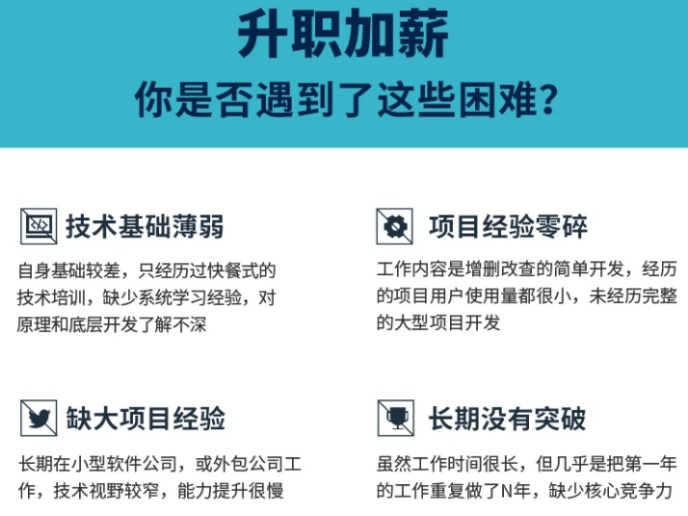
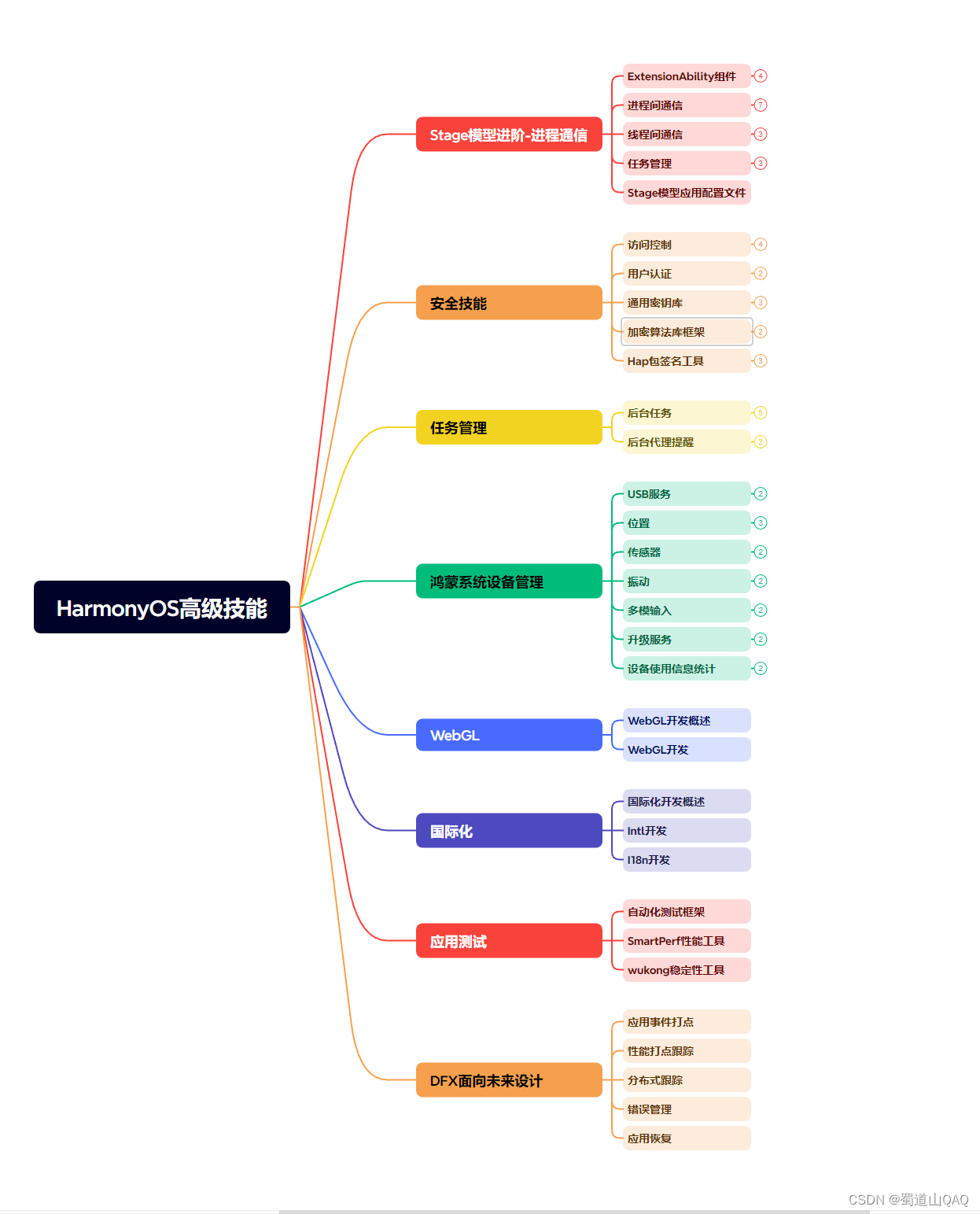
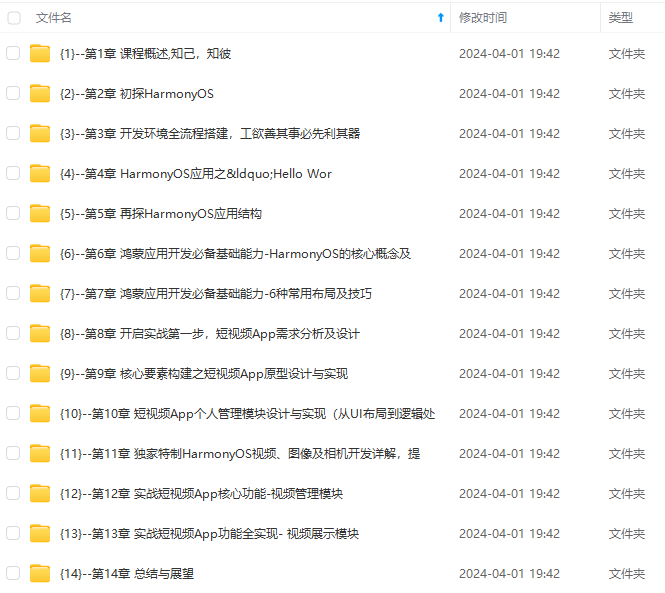
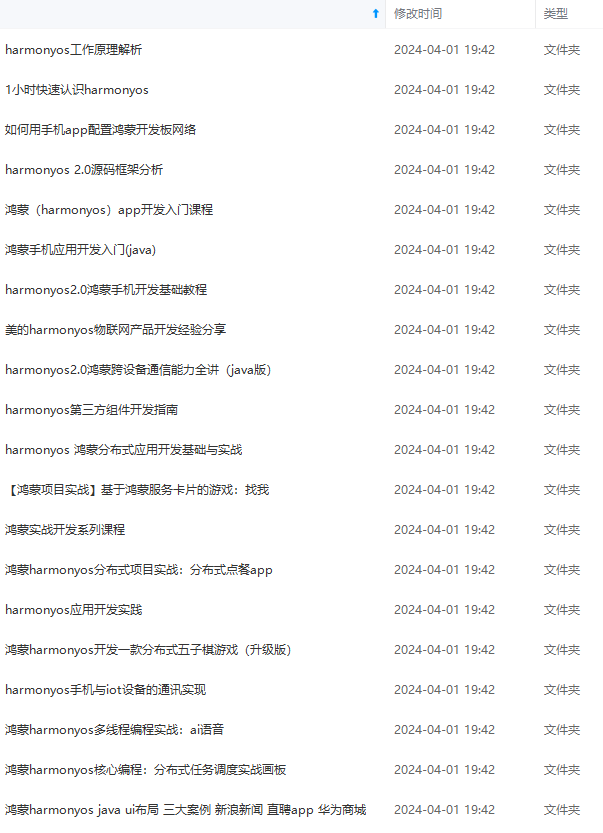
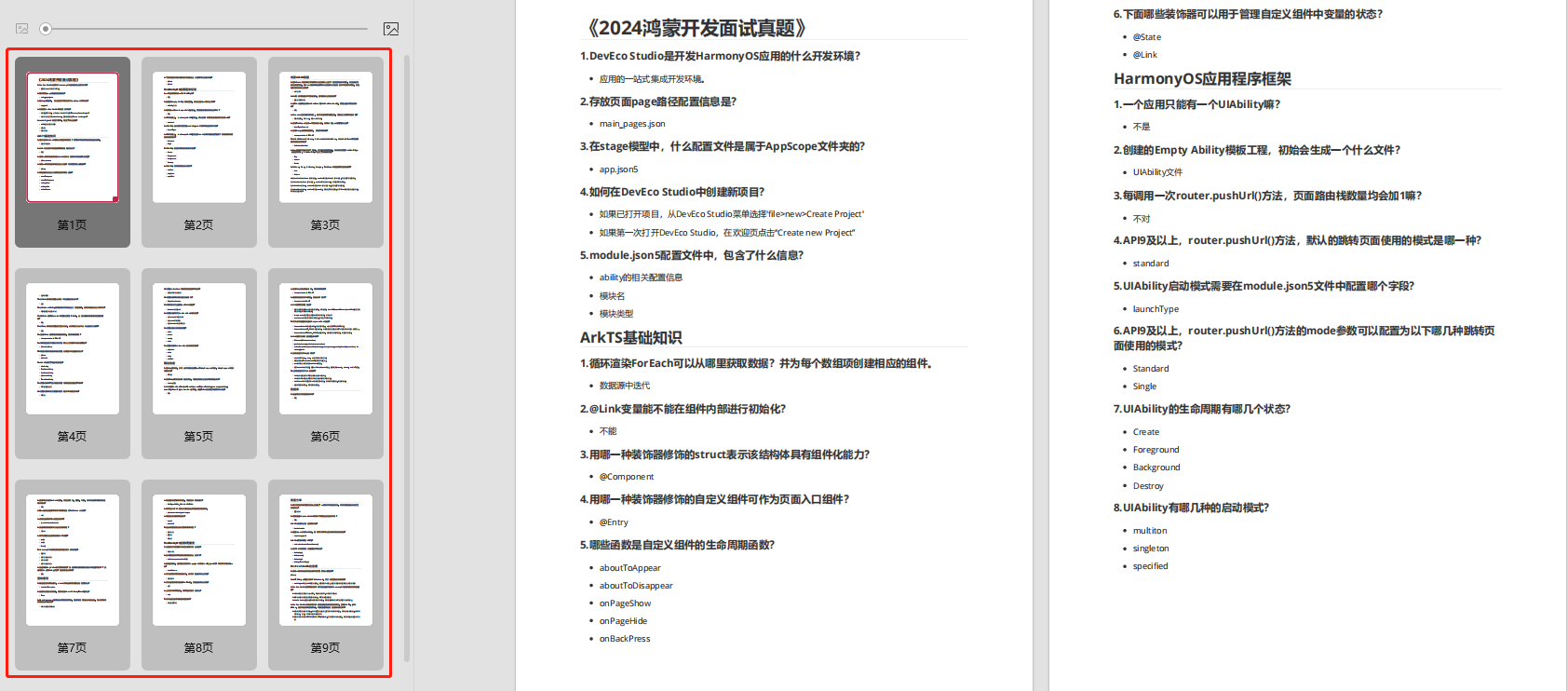
既有适合小白学习的零基础资料,也有适合3年以上经验的小伙伴深入学习提升的进阶课程,基本涵盖了95%以上HarmonyOS鸿蒙开发知识点,真正体系化!
由于文件比较大,这里只是将部分目录大纲截图出来,每个节点里面都包含大厂面经、学习笔记、源码讲义、实战项目、讲解视频,并且会持续更新
如果你觉得这些内容对你有帮助,可以添加VX:vip204888 (备注鸿蒙获取)

一个人可以走的很快,但一群人才能走的更远。不论你是正从事IT行业的老鸟或是对IT行业感兴趣的新人,都欢迎扫码加入我们的的圈子(技术交流、学习资源、职场吐槽、大厂内推、面试辅导),让我们一起学习成长!
- 当消息队列为空,管道的读端等待管道中有新内容可读,就会通过
epoll机制进入阻塞状态。 - 当有消息要处理,就会通过管道的写端写入内容,唤醒主线程。
同步屏障和异步消息是怎么实现的?
其实在Handler机制中,有三种消息类型:
同步消息。也就是普通的消息。异步消息。通过setAsynchronous(true)设置的消息。同步屏障消息。通过postSyncBarrier方法添加的消息,特点是target为空,也就是没有对应的handler。
这三者之间的关系如何呢?
- 正常情况下,同步消息和异步消息都是正常被处理,也就是根据时间when来取消息,处理消息。
- 当遇到同步屏障消息的时候,就开始从消息队列里面去找异步消息,找到了再根据时间决定阻塞还是返回消息。
也就是说同步屏障消息不会被返回,他只是一个标志,一个工具,遇到它就代表要去先行处理异步消息了。
所以同步屏障和异步消息的存在的意义就在于有些消息需要“加急处理”。
同步屏障和异步消息有具体的使用场景吗?
使用场景就很多了,比如绘制方法scheduleTraversals。
void scheduleTraversals() {
if (!mTraversalScheduled) {
mTraversalScheduled = true;
// 同步屏障,阻塞所有的同步消息
mTraversalBarrier = mHandler.getLooper().getQueue().postSyncBarrier();
// 通过 Choreographer 发送绘制任务
mChoreographer.postCallback(
Choreographer.CALLBACK_TRAVERSAL, mTraversalRunnable, null);
}
}
Message msg = mHandler.obtainMessage(MSG_DO_SCHEDULE_CALLBACK, action);
msg.arg1 = callbackType;
msg.setAsynchronous(true);
mHandler.sendMessageAtTime(msg, dueTime);
在该方法中加入了同步屏障,后续加入一个异步消息MSG_DO_SCHEDULE_CALLBACK,最后会执行到FrameDisplayEventReceiver,用于申请VSYNC信号。
Message消息被分发之后会怎么处理?消息怎么复用的?
再看看loop方法,在消息被分发之后,也就是执行了dispatchMessage方法之后,还偷偷做了一个操作——recycleUnchecked。
public static void loop() {
for (;;) {
Message msg = queue.next(); // might block
try {
msg.target.dispatchMessage(msg);
}
msg.recycleUnchecked();
}
}
//Message.java
private static Message sPool;
private static final int MAX_POOL_SIZE = 50;
void recycleUnchecked() {
flags = FLAG_IN_USE;
what = 0;
arg1 = 0;
arg2 = 0;
obj = null;
replyTo = null;
sendingUid = UID_NONE;
workSourceUid = UID_NONE;
when = 0;
target = null;
callback = null;
data = null;
synchronized (sPoolSync) {
if (sPoolSize < MAX_POOL_SIZE) {
next = sPool;
sPool = this;
sPoolSize++;
}
}
}
在recycleUnchecked方法中,释放了所有资源,然后将当前的空消息插入到sPool表头。
这里的sPool就是一个消息对象池,它也是一个链表结构的消息,最大长度为50。
那么Message又是怎么复用的呢?在Message的实例化方法obtain中:
public static Message obtain() {
synchronized (sPoolSync) {
if (sPool != null) {
Message m = sPool;
sPool = m.next;
m.next = null;
m.flags = 0; // clear in-use flag
sPoolSize--;
return m;
}
}
return new Message();
}
直接复用消息池sPool中的第一条消息,然后sPool指向下一个节点,消息池数量减一。
Looper是干嘛呢?怎么获取当前线程的Looper?为什么不直接用Map存储线程和对象呢?
在Handler发送消息之后,消息就被存储到MessageQueue中,而Looper就是一个管理消息队列的角色。Looper会从MessageQueue中不断的查找消息,也就是loop方法,并将消息交回给Handler进行处理。
而Looper的获取就是通过ThreadLocal机制:
static final ThreadLocal<Looper> sThreadLocal = new ThreadLocal<Looper>();
private static void prepare(boolean quitAllowed) {
if (sThreadLocal.get() != null) {
throw new RuntimeException("Only one Looper may be created per thread");
}
sThreadLocal.set(new Looper(quitAllowed));
}
public static @Nullable Looper myLooper() {
return sThreadLocal.get();
}
通过prepare方法创建Looper并且加入到sThreadLocal中,通过myLooper方法从sThreadLocal中获取Looper。
ThreadLocal运行机制?这种机制设计的好处?
下面就具体说说ThreadLocal运行机制。
//ThreadLocal.java
public T get() {
Thread t = Thread.currentThread();
ThreadLocalMap map = getMap(t);
if (map != null) {
ThreadLocalMap.Entry e = map.getEntry(this);
if (e != null) {
@SuppressWarnings("unchecked")
T result = (T)e.value;
return result;
}
}
return setInitialValue();
}
public void set(T value) {
Thread t = Thread.currentThread();
ThreadLocalMap map = getMap(t);
if (map != null)
map.set(this, value);
else
createMap(t, value);
}
从ThreadLocal类中的get和set方法可以大致看出来,有一个ThreadLocalMap变量,这个变量存储着键值对形式的数据。
key为this,也就是当前ThreadLocal变量。value为T,也就是要存储的值。
然后继续看看ThreadLocalMap哪来的,也就是getMap方法:
//ThreadLocal.java
ThreadLocalMap getMap(Thread t) {
return t.threadLocals;
}
//Thread.java
ThreadLocal.ThreadLocalMap threadLocals = null;
原来这个ThreadLocalMap变量是存储在线程类Thread中的。
所以ThreadLocal的基本机制就搞清楚了:
在每个线程中都有一个threadLocals变量,这个变量存储着ThreadLocal和对应的需要保存的对象。
这样带来的好处就是,在不同的线程,访问同一个ThreadLocal对象,但是能获取到的值却不一样。
挺神奇的是不是,其实就是其内部获取到的Map不同,Map和Thread绑定,所以虽然访问的是同一个ThreadLocal对象,但是访问的Map却不是同一个,所以取得值也不一样。
这样做有什么好处呢?为什么不直接用Map存储线程和对象呢?
打个比方:
ThreadLocal就是老师。Thread就是同学。Looper(需要的值)就是铅笔。
现在老师买了一批铅笔,然后想把这些铅笔发给同学们,怎么发呢?两种办法:
1、老师把每个铅笔上写好每个同学的名字,放到一个大盒子里面去(map),用的时候就让同学们自己来找。
这种做法就是Map里面存储的是同学和铅笔,然后用的时候通过同学来从这个Map里找铅笔。
这种做法就有点像使用一个Map,存储所有的线程和对象,不好的地方就在于会很混乱,每个线程之间有了联系,也容易造成内存泄漏。
2、老师把每个铅笔直接发给每个同学,放到同学的口袋里(map),用的时候每个同学从口袋里面拿出铅笔就可以了。
这种做法就是Map里面存储的是老师和铅笔,然后用的时候老师说一声,同学只需要从口袋里拿出来就行了。
很明显这种做法更科学,这也就是ThreadLocal的做法,因为铅笔本身就是同学自己在用,所以一开始就把铅笔交给同学自己保管是最好的,每个同学之间进行隔离。
还有哪些地方运用到了ThreadLocal机制?
比如:Choreographer。
public final class Choreographer {
// Thread local storage for the choreographer.
private static final ThreadLocal<Choreographer> sThreadInstance =
new ThreadLocal<Choreographer>() {
@Override
protected Choreographer initialValue() {
Looper looper = Looper.myLooper();
if (looper == null) {
throw new IllegalStateException("The current thread must have a looper!");
}
Choreographer choreographer = new Choreographer(looper, VSYNC_SOURCE_APP);
if (looper == Looper.getMainLooper()) {
mMainInstance = choreographer;
}
return choreographer;
}
};
private static volatile Choreographer mMainInstance;
Choreographer主要是主线程用的,用于配合 VSYNC中断信号。
所以这里使用ThreadLocal更多的意义在于完成线程单例的功能。
可以多次创建Looper吗?
Looper的创建是通过Looper.prepare方法实现的,而在prepare方法中就判断了,当前线程是否存在Looper对象,如果有,就会直接抛出异常:
private static void prepare(boolean quitAllowed) {
if (sThreadLocal.get() != null) {
throw new RuntimeException("Only one Looper may be created per thread");
}
sThreadLocal.set(new Looper(quitAllowed));
}
private Looper(boolean quitAllowed) {
mQueue = new MessageQueue(quitAllowed);
mThread = Thread.currentThread();
}
所以同一个线程,只能创建一个Looper,多次创建会报错。
Looper中的quitAllowed字段是啥?有什么用?
按照字面意思就是是否允许退出,我们看看他都在哪些地方用到了:
void quit(boolean safe) {
if (!mQuitAllowed) {
throw new IllegalStateException("Main thread not allowed to quit.");
}
synchronized (this) {
if (mQuitting) {
return;
}
mQuitting = true;
if (safe) {
removeAllFutureMessagesLocked();
} else {
removeAllMessagesLocked();
}
}
}
哦,就是这个quit方法用到了,如果这个字段为false,代表不允许退出,就会报错。
但是这个quit方法又是干嘛的呢?从来没用过呢。还有这个safe又是啥呢?
其实看名字就差不多能了解了,quit方法就是退出消息队列,终止消息循环。
- 首先设置了
mQuitting字段为true。 - 然后判断是否安全退出,如果安全退出,就执行
removeAllFutureMessagesLocked方法,它内部的逻辑是清空所有的延迟消息,之前没处理的非延迟消息还是需要取处理,然后设置非延迟消息的下一个节点为空(p.next=null)。 - 如果不是安全退出,就执行
removeAllMessagesLocked方法,直接清空所有的消息,然后设置消息队列指向空(mMessages = null)
然后看看当调用quit方法之后,消息的发送和处理:
//消息发送
boolean enqueueMessage(Message msg, long when) {
synchronized (this) {
if (mQuitting) {
IllegalStateException e = new IllegalStateException(
msg.target + " sending message to a Handler on a dead thread");
Log.w(TAG, e.getMessage(), e);
msg.recycle();
return false;
}
}
当调用了quit方法之后,mQuitting为true,消息就发不出去了,会报错。
再看看消息的处理,loop和next方法:
Message next() {
for (;;) {
synchronized (this) {
if (mQuitting) {
dispose();
return null;
}
}
}
}
public static void loop() {
for (;;) {
Message msg = queue.next();
if (msg == null) {
// No message indicates that the message queue is quitting.
return;
}
}
}
很明显,当mQuitting为true的时候,next方法返回null,那么loop方法中就会退出死循环。
那么这个quit方法一般是什么时候使用呢?
- 主线程中,一般情况下肯定不能退出,因为退出后主线程就停止了。所以是当APP需要退出的时候,就会调用quit方法,涉及到的消息是EXIT_APPLICATION,大家可以搜索下。
- 子线程中,如果消息都处理完了,就需要调用quit方法停止消息循环。
Looper.loop方法是死循环,为什么不会卡死(ANR)?
关于这个问题,强烈建议看看Gityuan的回答:https://www.zhihu.com/question/34652589
我大致总结下:
- 主线程本身就是需要一只运行的,因为要处理各个View,界面变化。所以需要这个死循环来保证主线程一直执行下去,不会被退出。
- 真正会卡死的操作是在某个消息处理的时候操作时间过长,导致掉帧、ANR,而不是loop方法本身。
- 在主线程以外,会有其他的线程来处理接受其他进程的事件,比如
Binder线程(ApplicationThread),会接受AMS发送来的事件 - 在收到跨进程消息后,会交给主线程的
Hanlder再进行消息分发。所以Activity的生命周期都是依靠主线程的Looper.loop,当收到不同Message时则采用相应措施,比如收到msg=H.LAUNCH_ACTIVITY,则调用ActivityThread.handleLaunchActivity()方法,最终执行到onCreate方法。 - 当没有消息的时候,会阻塞在loop的
queue.next()中的nativePollOnce()方法里,此时主线程会释放CPU资源进入休眠状态,直到下个消息到达或者有事务发生。所以死循环也不会特别消耗CPU资源。
Message是怎么找到它所属的Handler然后进行分发的?
在loop方法中,找到要处理的Message,然后调用了这么一句代码处理消息:
msg.target.dispatchMessage(msg);
所以是将消息交给了msg.target来处理,那么这个target是啥呢?
找找它的来头:
//Handler
private boolean enqueueMessage(MessageQueue queue,Message msg,long uptimeMillis) {
msg.target = this;
return queue.enqueueMessage(msg, uptimeMillis);
}
在使用Hanlder发送消息的时候,会设置msg.target = this,所以target就是当初把消息加到消息队列的那个Handler。
Handler 的 post(Runnable) 与 sendMessage 有什么区别
Hanlder中主要的发送消息可以分为两种:
- post(Runnable)
- sendMessage
public final boolean post(@NonNull Runnable r) {
return sendMessageDelayed(getPostMessage(r), 0);
}
private static Message getPostMessage(Runnable r) {
Message m = Message.obtain();
m.callback = r;
return m;
}
通过post的源码可知,其实post和sendMessage的区别就在于:
post方法给Message设置了一个callback。
那么这个callback有什么用呢?我们再转到消息处理的方法dispatchMessage中看看:
public void dispatchMessage(@NonNull Message msg) {
if (msg.callback != null) {
handleCallback(msg);
} else {
if (mCallback != null) {
if (mCallback.handleMessage(msg)) {
return;
}
}
handleMessage(msg);
}
}
private static void handleCallback(Message message) {
message.callback.run();
}
这段代码可以分为三部分看:
- 如果
msg.callback不为空,也就是通过post方法发送消息的时候,会把消息交给这个msg.callback进行处理,然后就没有后续了。 - 如果
msg.callback为空,也就是通过sendMessage发送消息的时候,会判断Handler当前的mCallback是否为空,如果不为空就交给Handler.Callback.handleMessage处理。 - 如果
mCallback.handleMessage返回true,则无后续了。 - 如果
mCallback.handleMessage返回false,则调用handler类重写的handleMessage方法。
所以post(Runnable) 与 sendMessage的区别就在于后续消息的处理方式,是交给msg.callback还是 Handler.Callback或者Handler.handleMessage。
Handler.Callback.handleMessage 和 Handler.handleMessage 有什么不一样?为什么这么设计?
接着上面的代码说,这两个处理方法的区别在于Handler.Callback.handleMessage方法是否返回true:
- 如果为
true,则不再执行Handler.handleMessage - 如果为
false,则两个方法都要执行。
那么什么时候有Callback,什么时候没有呢?这涉及到两种Hanlder的 创建方式:
val handler1= object : Handler(){
override fun handleMessage(msg: Message) {
super.handleMessage(msg)
}
}
val handler2 = Handler(object : Handler.Callback {
override fun handleMessage(msg: Message): Boolean {
return true
}
})
常用的方法就是第1种,派生一个Handler的子类并重写handleMessage方法。而第2种就是系统给我们提供了一种不需要派生子类的使用方法,只需要传入一个Callback即可。
Handler、Looper、MessageQueue、线程是一一对应关系吗?
- 一个线程只会有一个
Looper对象,所以线程和Looper是一一对应的。 MessageQueue对象是在new Looper的时候创建的,所以Looper和MessageQueue是一一对应的。Handler的作用只是将消息加到MessageQueue中,并后续取出消息后,根据消息的target字段分发给当初的那个handler,所以Handler对于Looper是可以多对一的,也就是多个Hanlder对象都可以用同一个线程、同一个Looper、同一个MessageQueue。
总结:Looper、MessageQueue、线程是一一对应关系,而他们与Handler是可以一对多的。
ActivityThread中做了哪些关于Handler的工作?(为什么主线程不需要单独创建Looper)
主要做了两件事:
1、在main方法中,创建了主线程的Looper和MessageQueue,并且调用loop方法开启了主线程的消息循环。
public static void main(String[] args) {
Looper.prepareMainLooper();
if (sMainThreadHandler == null) {
sMainThreadHandler = thread.getHandler();
}
Looper.loop();
throw new RuntimeException("Main thread loop unexpectedly exited");
}
2、创建了一个Handler来进行四大组件的启动停止等事件处理
final H mH = new H();
class H extends Handler {
public static final int BIND_APPLICATION = 110;
public static final int EXIT_APPLICATION = 111;
public static final int RECEIVER = 113;
public static final int CREATE_SERVICE = 114;
public static final int STOP_SERVICE = 116;
public static final int BIND_SERVICE = 121;
IdleHandler是啥?有什么使用场景?
之前说过,当MessageQueue没有消息的时候,就会阻塞在next方法中,其实在阻塞之前,MessageQueue还会做一件事,就是检查是否存在IdleHandler,如果有,就会去执行它的queueIdle方法。
private IdleHandler[] mPendingIdleHandlers;
Message next() {
int pendingIdleHandlerCount = -1;
for (;;) {
synchronized (this) {
//当消息执行完毕,就设置pendingIdleHandlerCount
if (pendingIdleHandlerCount < 0
&& (mMessages == null || now < mMessages.when)) {
pendingIdleHandlerCount = mIdleHandlers.size();
}
//初始化mPendingIdleHandlers
if (mPendingIdleHandlers == null) {
mPendingIdleHandlers = new IdleHandler[Math.max(pendingIdleHandlerCount, 4)];
}
//mIdleHandlers转为数组
mPendingIdleHandlers = mIdleHandlers.toArray(mPendingIdleHandlers);
}
// 遍历数组,处理每个IdleHandler
for (int i = 0; i < pendingIdleHandlerCount; i++) {
final IdleHandler idler = mPendingIdleHandlers[i];
mPendingIdleHandlers[i] = null; // release the reference to the handler
boolean keep = false;
try {
keep = idler.queueIdle();
} catch (Throwable t) {
Log.wtf(TAG, "IdleHandler threw exception", t);
}
//如果queueIdle方法返回false,则处理完就删除这个IdleHandler
if (!keep) {
synchronized (this) {
mIdleHandlers.remove(idler);
}
}
}
// Reset the idle handler count to 0 so we do not run them again.
pendingIdleHandlerCount = 0;
}
}
当没有消息处理的时候,就会去处理这个mIdleHandlers集合里面的每个IdleHandler对象,并调用其queueIdle方法。最后根据queueIdle返回值判断是否用完删除当前的IdleHandler。
然后看看IdleHandler是怎么加进去的:
Looper.myQueue().addIdleHandler(new IdleHandler() {
@Override
public boolean queueIdle() {
//做事情
return false;
}
});
public void addIdleHandler(@NonNull IdleHandler handler) {
if (handler == null) {
throw new NullPointerException("Can't add a null IdleHandler");
}
synchronized (this) {
mIdleHandlers.add(handler);
}
}
ok,综上所述,IdleHandler就是当消息队列里面没有当前要处理的消息了,需要堵塞之前,可以做一些空闲任务的处理。
常见的使用场景有:启动优化。
我们一般会把一些事件(比如界面view的绘制、赋值)放到onCreate方法或者onResume方法中。但是这两个方法其实都是在界面绘制之前调用的,也就是说一定程度上这两个方法的耗时会影响到启动时间。
所以我们可以把一些操作放到IdleHandler中,也就是界面绘制完成之后才去调用,这样就能减少启动时间了。
但是,这里需要注意下可能会有坑。
如果使用不当,IdleHandler会一直不执行,比如在View的onDraw方法里面无限制的直接或者间接调用View的invalidate方法。
其原因就在于onDraw方法中执行invalidate,会添加一个同步屏障消息,在等到异步消息之前,会阻塞在next方法,而等到FrameDisplayEventReceiver异步任务之后又会执行onDraw方法,从而无限循环。
HandlerThread是啥?有什么使用场景?
直接看源码:
public class HandlerThread extends Thread {
@Override
public void run() {
Looper.prepare();
synchronized (this) {
mLooper = Looper.myLooper();
notifyAll();
}
Process.setThreadPriority(mPriority);
onLooperPrepared();
Looper.loop();
}
哦,原来如此。HandlerThread就是一个封装了Looper的Thread类。
就是为了让我们在子线程里面更方便的使用Handler。
这里的加锁就是为了保证线程安全,获取当前线程的Looper对象,获取成功之后再通过notifyAll方法唤醒其他线程,那哪里调用了wait方法呢?
public Looper getLooper() {
if (!isAlive()) {
return null;
}
// If the thread has been started, wait until the looper has been created.
synchronized (this) {
while (isAlive() && mLooper == null) {
try {
wait();
} catch (InterruptedException e) {
}
}
}
return mLooper;
}
就是getLooper方法,所以wait的意思就是等待Looper创建好,那边创建好之后再通知这边正确返回Looper。
IntentService是啥?有什么使用场景?
老规矩,直接看源码:
public abstract class IntentService extends Service {
private final class ServiceHandler extends Handler {
public ServiceHandler(Looper looper) {
super(looper);
}
@Override
public void handleMessage(Message msg) {
onHandleIntent((Intent)msg.obj);
stopSelf(msg.arg1);
}
}
@Override
public void onCreate() {
super.onCreate();
HandlerThread thread = new HandlerThread("IntentService[" + mName + "]");
thread.start();
mServiceLooper = thread.getLooper();
mServiceHandler = new ServiceHandler(mServiceLooper);
}
@Override
public void onStart(@Nullable Intent intent, int startId) {
Message msg = mServiceHandler.obtainMessage();
msg.arg1 = startId;
msg.obj = intent;
lic abstract class IntentService extends Service {
private final class ServiceHandler extends Handler {
public ServiceHandler(Looper looper) {
super(looper);
}
@Override
public void handleMessage(Message msg) {
onHandleIntent((Intent)msg.obj);
stopSelf(msg.arg1);
}
}
@Override
public void onCreate() {
super.onCreate();
HandlerThread thread = new HandlerThread("IntentService[" + mName + "]");
thread.start();
mServiceLooper = thread.getLooper();
mServiceHandler = new ServiceHandler(mServiceLooper);
}
@Override
public void onStart(@Nullable Intent intent, int startId) {
Message msg = mServiceHandler.obtainMessage();
msg.arg1 = startId;
msg.obj = intent;





















 577
577











 被折叠的 条评论
为什么被折叠?
被折叠的 条评论
为什么被折叠?








